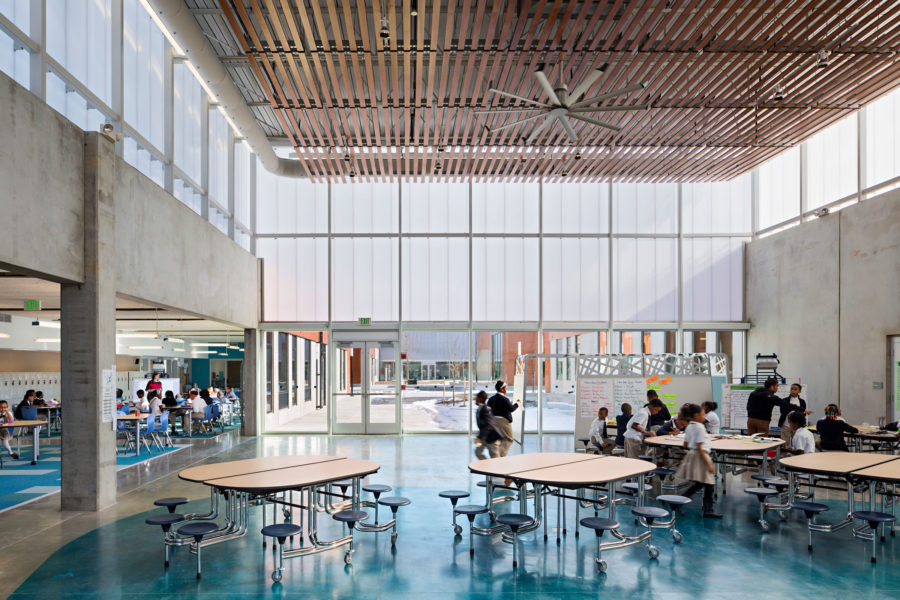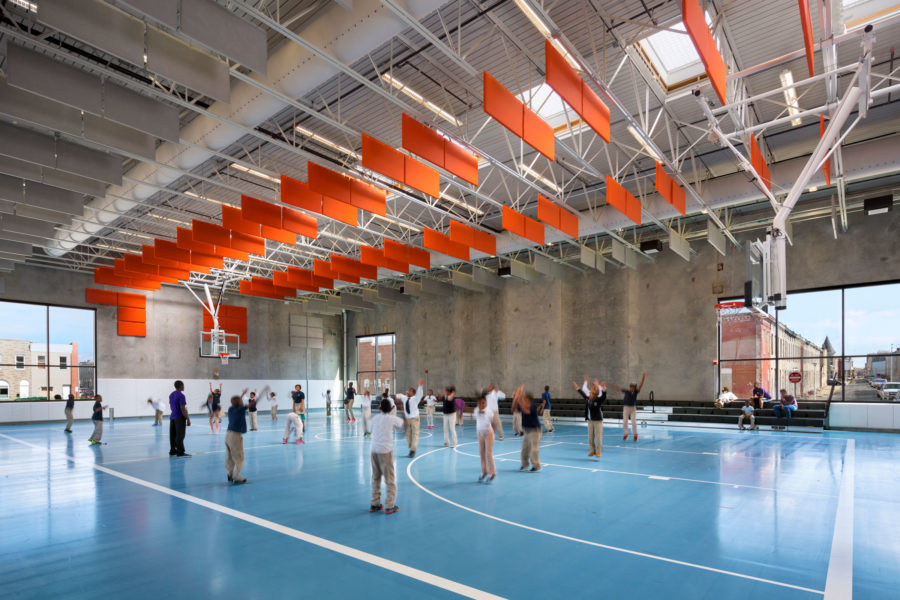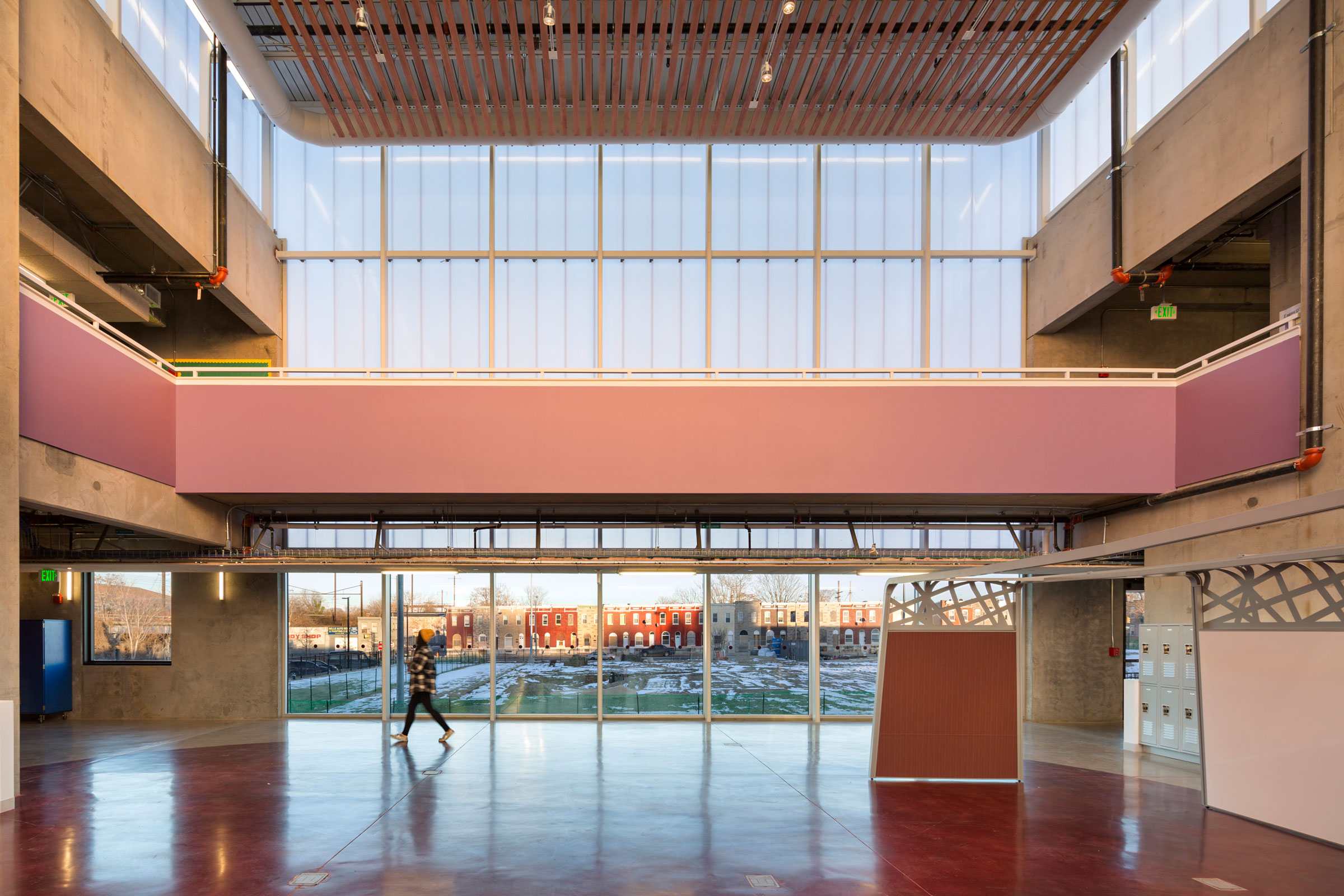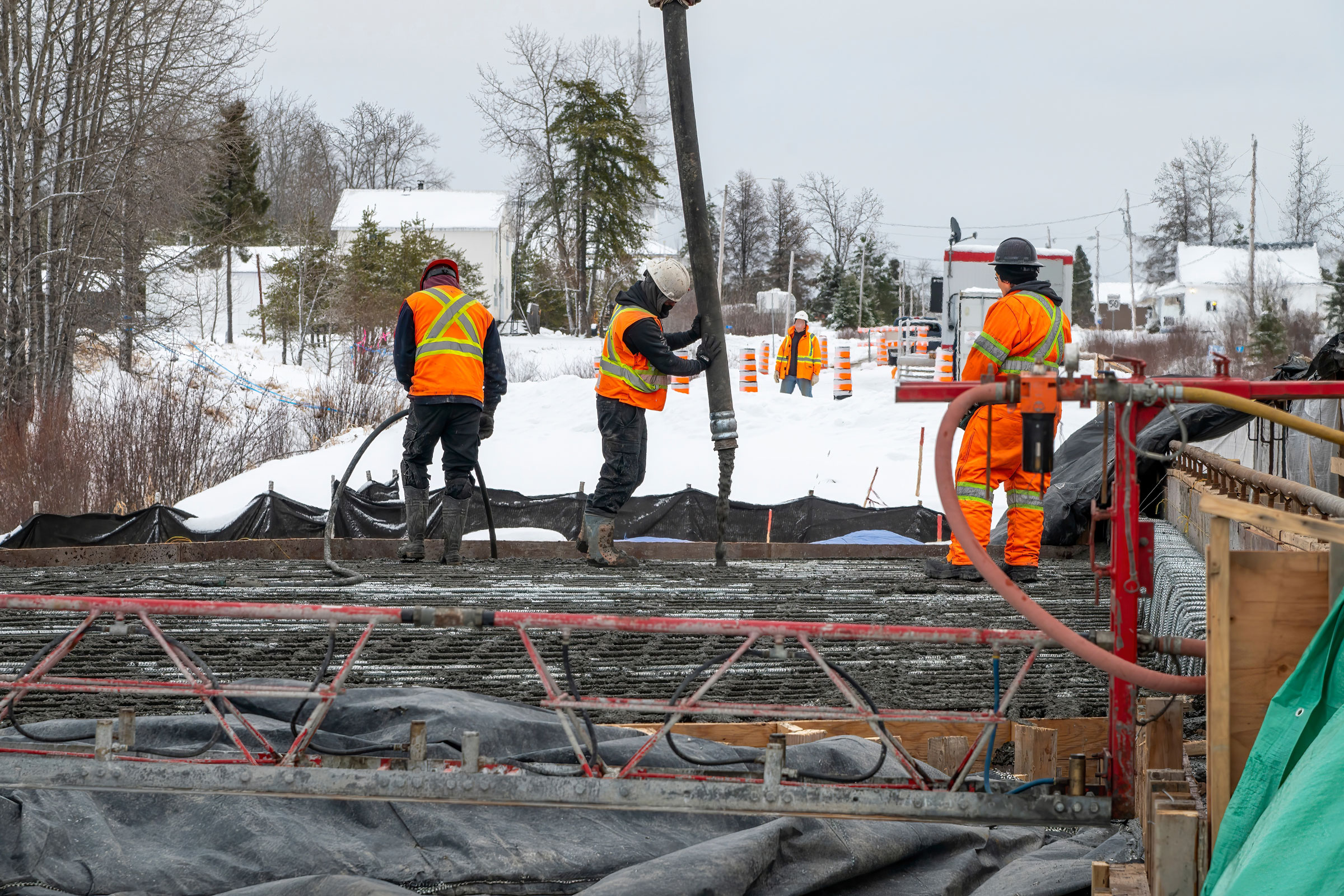Story at a glance:
- ROGERS PARTNERS built this Baltimore public school to offer outdoor healthy spaces for students as well as space for the community.
- As a result of COVID-19, all schools must adapt to suit students’ needs while prioritizing health and safety. Some experts say the Henderson-Hopkins School is an example of how to design differently.
- Henderson-Hopkins offers indoor/outdoor learning, flexible online teaching, a strong community focus, innovative air circulation, LEED-standard daylighting, and more.
When Baltimore’s Henderson-Hopkins School opened in 2014, administrators knew they were on to something, but no one could have predicted just how quickly some of their methods—including online learning and smaller, flexible work groups—would become a consideration for schools all over the globe.
With COVID-19 cases surging across North America in early 2020, schools everywhere began to close. Most continue to be affected—some offering 100% remote learning, some a mix of e-learning and in-person studies, some schooling in parks on sunny days, and many schooling in masks.
Annette Campbell Anderson, deputy director of the Johns Hopkins University Center for Safe and Healthy Schools, says it’s a topic future school leaders are talking about now every day as they contemplate what it means to be an educational leader in the age of COVID. What, they wonder, really makes a building safe for students to learn in?
Anderson says comprehensive criteria needs to come from public health officials and be consistent across schools, but that unfortunately has not been the case in 2020, as educators and parents alike grapple with inconsistent messaging and protocols across the US. While some schools practice 3 feet of social distancing, others follow the standard rule of 6; still other educators give students “mask breaks.” “You have to have some tacit agreement about what safety looks like,” Anderson says.
The Elmer A. Henderson: A Johns Hopkins Partnership School and the Harry and Jeanette Weinberg Early Childhood Center, together called Henderson-Hopkins School, is the first new Baltimore public school built in more than 20 years. The project was the cornerstone of a redevelopment plan for an East Baltimore neighborhood, integrating innovative educational facilities with community resources, according to Vincent Lee, associate partner at ROGERS PARTNERS Architects+Urban Designers, the firm who designed the school.
The school serves children from 6 weeks old through 8th grade as well as acts as a family resource center with everything from housing services to health access. “It’s a way to connect some of the services in the community through the trust of the school building,” Anderson says.

The Henderson-Hopkins School serves children from 6 weeks old through 8th grade as well as acts as a family resource center. Photo courtesy of Albert Vecerka/Esto
Some design strategies used in the school could be helpful in thinking about future, safe school design, Lee says. The school is built around a cluster of structures, inspired by East Baltimore’s row houses, stoops, and social civic spaces. Lee calls the campus a microcosm of the city, as students are grouped by age in small-scale houses bisected by main streets and side streets.
Lee has been an architect for 25 years, and ROGERS PARTNERS specializes in school design, particularly of schools with unique learning models. Lee says some of the design strategies used at Henderson-Hopkins, which has won multiple AIA awards, may help in reopening schools post-COVID, including having flexible spaces and smaller clusters of students in outdoor learning areas.
Each small building at Henderson-Hopkins has two grades, and each also has an exterior classroom for students to learn in. “Having space that is set up from day one as an exterior learning space—I think that’s something we’re going to see more of,” Lee says. Large doors open between buildings and a large commons room with a high ceiling and HVLS fan also connects students while keeping air flowing.

Photo courtesy of Albert Vecerka/Esto
In addition to the school houses, Henderson-Hopkins has a gym, auditorium, and library that are for students as well as the public. It’s truly a community space, unlike so many other school buildings, Lee says. “When most schools say they are open to the public they mean after 4 o’clock.”
Flexibility in teaching style will continue to be important post-COVID, Lee thinks, and many can learn from Henderson-Hopkins. “The model they set up did not rely on one mode or pedagogy of teaching. There are conventional classrooms, small classrooms, flexible spaces, and common spaces, and the idea is to find the mode and methodology each student works the best in,” he says.
Lee says the administration was already working to incorporate more online learning within the school before the pandemic. He likes to tell the story of talking with the dean in charge when the school opened. “He told me every educator has their 15 minutes of material they’re the best on, and that the rest of the time they’re emulating someone else’s best 15 minutes. He wanted to set things up so students could do video learning and get the best 15 minutes from the source, which I think is a positive take on online learning people may not be taking advantage of.”
As for the early design and build of Henderson-Hopkins, the team used an insulated precast concrete panel system that ROGERS PARTNERS customized and modified. That allowed them to get the school up fast. Lee says 97% of the occupied spaces get plentiful natural light, meeting the daylighting requirements of LEED with 275 windows and 40 skylights. “A graciousness of space and light was really important,” he says.
Anderson, who is also one of founders of the eSchool+ Initiative, a cross-disciplinary collaboration tracking state reopening guidance in an effort to ensure equity in the pandemic response, ponders how schools will be built post-COVID.
“We know we have to have space for social distancing, but we’ve also spent the last 30 years talking about constructivist perspective in education; we’ve asked children to sit at tables, not desks, and we’ve had community meetings focused around having space together on floors. Now because of COVID-19 we’ve asked everyone to go back and sit at a desk all day and not necessarily have interaction with a larger group of peers. I do think that will have an impact.”

The Henderson-Hopkins School’s gym is also open to the community. Photo courtesy of Albert Vecerka/Esto
Students’ overall physical health is another huge factor, she says. How can we be sure they’re breathing fresh air? What about washing their hands? The design needs to make it easy. As schools reopen, she says she and colleagues are already considering the impact on architecture, from air circulation to more portable handwashing solutions.
Many older buildings have outdated ventilation systems and a lack of sinks, for instance. “Some of these older buildings did not take into account the need for students to wash their hands several times a day so they don’t have sinks in classrooms,” Anderson says. “How do you deal with disruption to instruction, having kids jump up all day to wash their hands down the hall? These are design questions I think we will have to tackle sooner than later.”
Similarly, older schools, many buildings being 100-plus years old, have outdated ventilation systems. “How can those buildings incorporate ventilation systems that do better jobs of filtering? How can we create spaces that really honor social distancing? How can we incorporate more of the capacity to handwash?” Anderson asks. “Those are things we now have to go back to and think about with school design. I do think it’s going to have a big impact on how we think about how we design our schools.”




